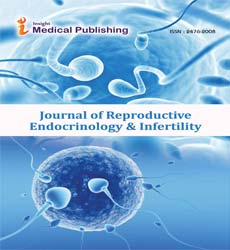Progesterone and Luteal Phase Deficiency: Endocrinological Insights into Recurrent Pregnancy Loss
Nicole Benedicte*
Department of Epidemiology, Johns Hopkins Bloomberg School of Public Health, Baltimore MD, USA
Published Date: 2025-02-28Nicole Benedicte*
Department of Epidemiology, Johns Hopkins Bloomberg School of Public Health, Baltimore MD, USA
Corresponding author:
Nicole Benedicte,
Department of Epidemiology, Johns Hopkins Bloomberg School of Public Health, Baltimore MD, USA,
E-mail: nicole@benedicte.edu
Received date: February 01, 2025, Manuscript No. ipjrei-25-20622; Editor assigned date: February 03, 2025, PreQC No. ipjrei-25-20622 (PQ); Reviewed date: February 15, 2025, QC No. ipjrei-25-20622; Revised date: February 22, 2025, Manuscript No. ipjrei-25-20622 (R); Published date: February 28, 2025, DOI: 10.36648/ipwhrm.10.1.69
Citation: Benedicte N (2025) Progesterone and Luteal Phase Deficiency: Endocrinological Insights into Recurrent Pregnancy Loss. J Reprod Endocrinol InfertVol.10 No.1: 69.
Introduction
Progesterone plays a fundamental role in establishing and maintaining early pregnancy by supporting endometrial receptivity, modulating immune tolerance, and sustaining the luteal phase until placental takeover. Luteal phase deficiency (LPD), characterized by insufficient progesterone secretion or inadequate endometrial response, has long been implicated as a potential cause of recurrent pregnancy loss (RPL). Although the association remains debated, emerging endocrinological insights highlight how progesterone insufficiency may contribute to implantation failure, early miscarriage, and recurrent reproductive failure, making it an important area of clinical investigation [1].
Description
The luteal phase begins after ovulation with the formation of the corpus luteum, which produces progesterone essential for transforming the proliferative endometrium into a secretory state receptive to embryo implantation. Inadequate luteal function, whether due to poor folliculogenesis, insufficient corpus luteum activity, or impaired endometrial responsiveness, can result in shortened luteal phases and suboptimal progesterone exposure. This endocrinological imbalance not only compromises implantation but also increases the likelihood of early pregnancy loss [2].
Clinical evaluation of luteal function remains challenging, as serum progesterone levels and endometrial histology often provide inconsistent or limited diagnostic accuracy. However, advances in reproductive endocrinology now incorporate serial luteal progesterone measurements, ultrasound-based corpus luteum assessment, and molecular biomarkers of endometrial receptivity to better understand LPD Furthermore, conditions such as polycystic ovary syndrome (PCOS) These associations highlight the multifactorial nature of RPL and the role [3].
Thyroid dysfunction and hyperprolactinemia are frequently associated with luteal defects, linking systemic endocrine disorders with recurrent pregnancy complications. Therapeutically, progesterone supplementation has become a cornerstone in managing suspected LPD, particularly in women with recurrent miscarriage or undergoing assisted reproductive technologies (ART). Various formulations, including oral, intramuscular, and vaginal preparations, have been employed with varying efficacy. Vaginal progesterone is favored for its direct uterine effects, while intramuscular injections provide consistent systemic levels. [5].
Conclusion
Progesterone deficiency in the luteal phase represents a critical endocrinological factor contributing to recurrent pregnancy loss, although its diagnosis and clinical significance remain complex. Advances in understanding corpus luteum physiology, endometrial receptivity, and systemic endocrine influences provide deeper insight into the role of LPD in reproductive failure. Progesterone supplementation, despite variable outcomes, offers a promising therapeutic approach, particularly in selected patient populations. Integrating endocrinological evaluation with personalized treatment strategies may ultimately improve pregnancy outcomes and provide hope for women experiencing recurrent pregnancy loss.
Acknowledgement
None
Conflict of Interest
None
References
- Mete O, Lopes MB (2017) Overview of the 2017 WHO classification of pituitary tumors. Endocr Pathol 28: 228-243
Google Scholar Cross Ref Indexed at
- Sav A (2025) Editorial: Diagnosis and treatment of non-functioning pituitary tumors. Front Endocrinol 16: 1558988
Google Scholar Cross Ref Indexed at
- Asa SL, Mete O, Perry A, Osamura RY (2022) Overview of the 2022 WHO classification of pituitary tumors. Endocr Pathol 33: 6-26
Google Scholar Cross Ref Indexed at
- Rey RA (2020) Biomarkers of male hypogonadism in childhood and adolescence. Adv Lab Med 1: 20200024
Google Scholar Cross Ref Indexed at
- Otani T (2019) Clinical review of ejaculatory dysfunction. Reprod Med Biol 18: 331-343
Open Access Journals
- Aquaculture & Veterinary Science
- Chemistry & Chemical Sciences
- Clinical Sciences
- Engineering
- General Science
- Genetics & Molecular Biology
- Health Care & Nursing
- Immunology & Microbiology
- Materials Science
- Mathematics & Physics
- Medical Sciences
- Neurology & Psychiatry
- Oncology & Cancer Science
- Pharmaceutical Sciences
